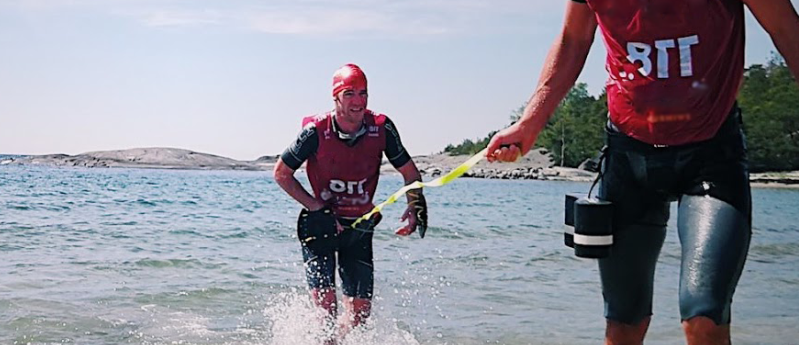The tether, or tow line, is essentially a 3m (or roughly 10ft) cord that Swimrun teams use to stay in contact with each other in the water and on land during a Swimrun. Swimrun event rules typically state that teams must stay within 10 ft of each other at all times for safety. Why is it a thing?
There are some tactical advantages for using a tether. Mainly, it allows teams to stay in contact during swim legs and stay in each other’s draft. The advantages of drafting in the water are pretty well understood. In longer swimrun events, recovering behind the lead swimmer can keep everyone fresh, which can pay off later in the race. Teams can draft with different strategies. Teams will typically stay tethered during run legs and we would definitely recommend this. The tether provides real-time haptic feedback that lets you know exactly how your partner is doing pace-wise. If a team member is not having a good day, it’s not uncommon for a runner to tow their partner up a steep climb. The tether can keep a team moving forward until they recover or hit the next aid station.
(PRO TIP: if the tether is too long during a race, make a knot on the line during the next run leg.) Teams then attach each end to their wetsuit (some suits have integrated loops for attaching one), to the cord of your pull buoy waist loop (if you’re using that type of pull buoy mount), or to a waist utility belt a la Batman. Chris uses a “tactical military grade” nylon belt that has a loop built into the belt that sells for around $13.00 on Amazon. Companies like Orca and ARK Sports also make these belts. To make your tether, we recommend using either a thick, bright-colored 1/4” (6mm) Shock Cord or ½-¾” nylon webbing material and attach carabiners on either side.
We recommend a highly visible color that can be easily seen in murky lakes and crystal clear ocean waters. You don’t need anything special in terms of carabiners, something that’s light and basic (but not easily snapped) will do the trick. As with anything Swimrun, you should experiment in training to see what works best for you. It definitely takes some getting used to swim and run with a tether…and dinner plate-sized hand paddles…and a giant pull buoy. Basically though, the partner being towed wants to keep the tether in their midline so that they can swim freely without getting all caught up in the tether. Check out our podcast episode about the Tether and our DIY video to learn how to make your own tether.

